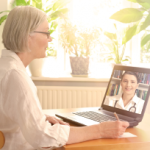
anttoniart / shutterstock.com
Our hospitals have had their finest hour in the care of acutely ill inpatients during the COVID-19 pandemic, including dealing with allocation decisions fairly and transparently, maximizing good outcomes and remaining cognizant of the enduring ethics of healthcare. The honorable traditions of self-effacing conduct and acceptance of some level of personal risk by healthcare professionals have justifiably been lauded within the professions and in the broader society. We have endeavored to meet the needs of patients competently, efficiently and without consideration of disability, ethnicity, citizenship status, social or economic position, or other judgments of a patient’s social worth.
Where we are, and will be, in the care of patients in an ambulatory setting in the post-COVID-19 era remains unresolved. The new normal is telemedicine. The reasons are understandable, including the need to protect our patients from COVID-19 exposure, to protect our staffs and ourselves, to have safe waiting areas, to have adequate personal protective equipment and to accommodate simple matters, such as cleaning examination rooms.
For the foreseeable future, live, face-to-face visits with patients will be the exception. This will be aggravated by inevitable time and space constraints in clinic areas, all of which will affect throughput.
Telemedicine has provided some revenue flow for healthcare networks that have been severely affected by the suspension of profitable clinical services during the pandemic. In rheumatology, televisits are transactional; we get some idea of how a patient is progressing and an answer to the “how is your pain or swelling?” or “how long did the last knee injection provide relief?” questions. We can also ask the global questions: Rate your status on a 1–10 scale, where 1 is best, 10 is worst.1 Medications can be reconciled, and appropriate refills placed.
The path forward in the new age of telemedicine evokes a new set of ethical concerns. Although presently necessary as a matter of safety for everyone, including patients, those who would accompany patients to outpatient clinic encounters, ourselves and our support staffs, it has not as yet been demonstrated that telemedicine is the clinical or ethical equivalent of face-to-face medical encounters. Neither has it been sufficiently demonstrated that it can be delivered with the same level of clinical competence as can face-to-face ambulatory care—competence being the first moral obligation of healthcare professionals.
Medical Professionalism
To suggest nothing will change in a new world of predominantly telemedicine is an assertion that currently cannot be supported. From the time a patient enters a physician’s office until their departure, important social dimensions to the encounter play out. These include greetings from familiar members of the staff and those who schedule follow-up visits and arrange for consultative referral, laboratory and imaging appointments. Patients have long-standing relationships with our support staffs and to diminish them with electronic, device-generated registration, referral and sign-out diminishes the therapeutic relationship.
The encounter itself, where decisions are made to continue current management or to make major changes in treatment plans, is different in telemedicine. Are such changes made confidently in remote encounters, and are patients and physicians confident making such decisions? During a telemedicine encounter, we can perform data entry and order studies, referrals and treatments, but the baseline uncertainty is fraught with new concerns generated by not being there.
The encounters of doctor and patient in telemedicine are transactional; the question remains whether they can be transformative and instrumental in enhancing human flourishing, one of the noble goals of medicine. The line between a telemedicine visit and a reassuring callback to a patient is blurry. If we now charge patients for the courtesy of a callback to provide results of completed studies, including the reassurance that results are normal or improved or to learn whether a newly prescribed treatment has helped, medical practice will resemble the billable-hours model of law practice. This is not to disparage law practice, but medicine has been different. This change risks commodifying the historic essence of medicine.
As we attempt to maintain the relational side of medicine, we must ask whether face-to-face visits will be limited to those needing some technical procedure. This seems an underutilization of the skills of some of the most humanistic physicians, such as those who provide primary care, allocating them to remote, electronic device-dominated modes of practice.



